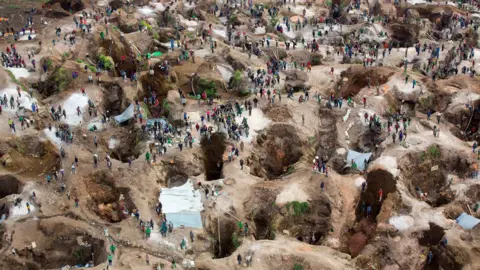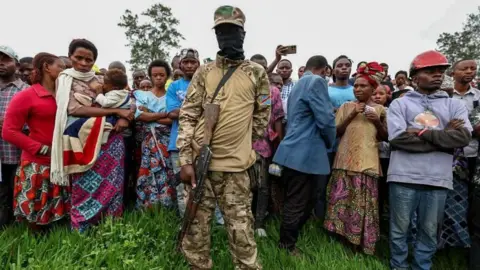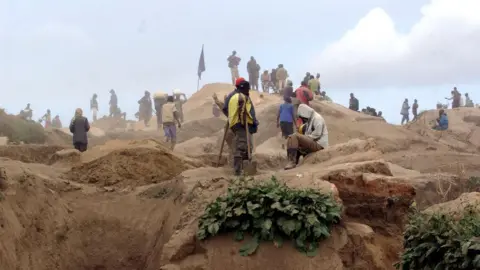 Getty Photographs
Getty PhotographsThere’s a good likelihood that inside your cell phone is a miniscule quantity of a metallic that began its journey buried within the earth of jap Democratic Republic of Congo, the place a conflict is at the moment raging.
It might even be instantly linked to the M23 insurgent group that made international headlines this week.
The tantalum inside your system weighs lower than half of the typical backyard pea however is crucial for the environment friendly functioning of a smartphone, and virtually all different refined digital gadgets.
The distinctive properties of this uncommon, blue-grey, lustrous metallic – together with having the ability to maintain a excessive cost in comparison with its dimension, whereas working in a variety of temperatures – make it a super materials for tiny capacitors, which quickly retailer vitality.
It’s also mined in Rwanda, Brazil and Nigeria however not less than 40% – and perhaps extra – of the ingredient’s international provide comes from DR Congo and a few of the key mining areas at the moment are beneath the management of the M23.
The present wave of combating has been occurring for months, however the rebels grabbed consideration with Sunday’s assault on the very important buying and selling and transport hub of Goma. Town, bordering Rwanda, is a regional centre for the mining enterprise
Over the previous 12 months, the M23 has made fast advances throughout the mineral-rich east of DR Congo, taking areas the place coltan – the ore from which tantalum is extracted – is mined.
Like scores of different armed teams working within the space, the M23 started as an outfit defending the rights of an ethnic group perceived to be beneath menace. However as its territory has expanded, mining has grow to be an important supply of earnings, paying for fighters and weapons.
Final April, it seized Rubaya, the city on the coronary heart of the nation’s coltan trade.
Mineral extraction on this area shouldn’t be within the fingers of multinational conglomerates – as an alternative 1000’s of people toil in open pits that honeycomb the panorama, or underground, in extraordinarily unsafe and unhealthy circumstances.
 Monusco
MonuscoThey’re a part of a posh, and but casual, community that sees the rocks faraway from the bottom utilizing shovels, dropped at the floor, crushed, washed, taxed, bought after which exported to be additional purified and finally smelted.
As soon as the M23 moved into Rubaya, the rebels established what a UN group of specialists described as a “state-like administration”, issuing permits to the diggers and merchants and demanding an annual charge of $25 (£20) and $250 respectively. The M23 doubled the diggers’ wages to make sure they’d stick with it working.
It runs the world as a monopoly ensuring – by means of the specter of arrest and detention – that solely its authorised merchants are in a position to do enterprise.
The M23 additionally fees a levy of $7 on every kilogramme of coltan. The UN group of specialists estimated that in consequence the M23 earns about $800,000 a month from coltan taxation in Rubaya. That cash is sort of actually then used to fund the riot.
There’s a query mark hanging over how the ore extracted from M23-controlled areas will get into the worldwide provide chain.
Neighbouring Rwanda, which is seen as backing the M23, is on the centre of the reply, the UN specialists say.
Theoretically, a certification scheme – referred to as the Progressive Tin Provide Chain Initiative (Itsci) – ought to imply that what goes right into a telephone handset and different electronics doesn’t come from areas of battle the place it might be used to fund armed teams accountable for finishing up atrocities.
 EPA
EPAThe US’ Dodd-Frank Act handed in 2010, and an identical piece of EU laws, is geared toward making certain that firms buying tin, tantalum, tungsten and gold – so-called “battle minerals” – will not be inadvertently funding violence.
However Itsci has come beneath some criticism.
Ken Matthysen, a safety and useful resource administration knowledgeable with unbiased analysis group Ipis, highlights that the dispersed nature of a whole lot of small-scale mines make it troublesome for the native authorities to watch precisely what’s going on in every single place.
Itsci tags needs to be placed on luggage on the mine itself, to show the origin of the minerals inside, however usually they get transported to a group level the place it turns into more durable to hint the place the ore really got here from, Mr Matthysen mentioned.
He added that there’s additionally a doable situation with corruption.
“There may be even an accusation of the state brokers promoting tags to merchants, as a result of they do not make a very good dwelling. So the merchants then go round jap DR Congo and so they tag the luggage themselves.”
Itsci didn’t reply to a BBC request for remark, however has prior to now defended its file saying that the scheme has been subjected to a rigorous unbiased audit. It has additionally been praised for bringing “prosperity for tons of of 1000’s of small-scale miners”.
Within the case of Rubaya, Itsci suspended its operations there quickly after the M23 entered the city.
Nonetheless, the group has managed to proceed exporting coltan.
The UN specialists map a circuitous route exhibiting how it’s transported to shut to the Rwandan border. It’s then transferred to “heavy-duty vans” that wanted the highway to be widened with the intention to accommodate them.
Rwanda has its personal coltan mines however the specialists say that the uncertified coltan is combined with Rwandan manufacturing resulting in a “vital contamination of provide chains”.
The M23 was already concerned within the coltan enterprise earlier than the seize of Rubaya – organising roadblocks and charging charges to cross them, in keeping with Mr Matthysen.
“Lots of the commerce of those minerals went by means of M23-controlled space in direction of Rwanda. So even then, Rwanda was cashing in on the instability in jap DR Congo and we noticed the export volumes to Rwanda have been already growing,” he instructed the BBC.
 AFP
AFPFigures from the US Geological Survey present that Rwanda’s coltan exports rose by 50% between 2022 and 2023. Mr Matthysen mentioned this might not have all come from Rwanda.
In a strong defence of Rwanda’s place, authorities spokesperson Yolande Makolo reiterated to the BBC that there have been minerals and refining capability in her personal nation.
“It’s totally cynical to take a problem like what’s taking place in jap DRC, the place a persecuted group is combating for its rights… and turning [it] into a problem of fabric profit,” she added.
Rwandan President Paul Kagame has additionally dismissed the UN specialists’ stories, pouring scorn on their “experience”.
A lot of the east of DR Congo has been blighted by battle for a few years, elevating questions on who has been benefitting and whether or not armed teams are cashing in on what’s dug out of the bottom there.
With the intention to spotlight the difficulty and its connection to the smartphone trade, the Congolese authorities filed felony complaints in France and Belgium on the finish of final 12 months towards subsidiaries of the tech big Apple, accusing it of utilizing “battle minerals”.
Apple has disputed the allegation and identified that since early 2024, due to the escalating battle and the difficulties of certification, it stopped sourcing tantalum, amongst different metals, from each DR Congo and Rwanda.
Different firms haven’t been so clear, which implies that because the M23 seizes extra territory these small bits of tantalum from the mines that they management may nonetheless make their method into the gadgets that we have now come to depend on.
Extra BBC tales on the battle in DR Congo:
 Getty Photographs/BBC
Getty Photographs/BBC
